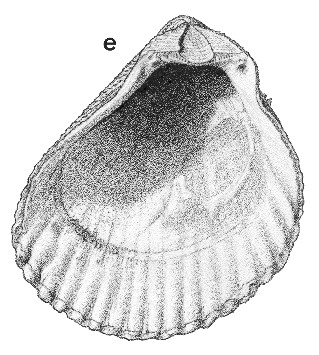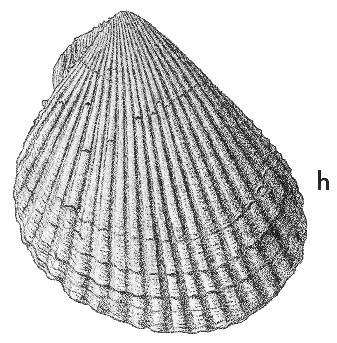
Revised descriptions of New Zealand Cenozoic Mollusca from Beu and Maxwell (1990)

 | Revised descriptions of New Zealand Cenozoic Mollusca from Beu and Maxwell (1990) | 
|
  (Pl. 18e): GS9520, J41/f8029, Awamoa Creek, Oamaru, Altonian (GNS) |
  (Pl. 18h): GS9520, J41/f8029, Awamoa Creek, Oamaru, Altonian (GNS) |
Beu & Maxwell (1990): Chapter 11; p. 180; pl. 18 e,h.
Synonymy: Lima colorata Hutton 1873b, p.33; ? Lima paucisulcata Hutton 1873b, p. 33; L. colorata colorata
Classification: Limidae
Description: Rather large for genus (height 65-108 mm), robust, strongly oblique, exterior of many specimens red or black. Posterior ear well developed, anterior ear much smaller, scarcely projecting beyond antero-dorsal margin. Anterior area strongly depressed, flattened or slightly concave. Flanks with 18-23 prominent radial costae of squarish section, crests flattened or slightly convex, becoming more convex distally, showing through on interior of some shells. Crests with sparse scales, usually worn off and typically best developed towards anterior and posterior margins of flanks. Interspaces smooth except for fine oblique ridges proximally and exceedingly fine commarginal and radial striae elsewhere. Anterior area with growth ridges and a variable number of low, narrow, scaly or nodulose radial costae, in some shells present across whole width, in others confined to posterior part. Anterior ear with rather coarse growth ridges; posterior ear with growth ridges and scattered scales, with weak radial costae in only a few specimens. Cardinal area highly variable in size; resilifer large.
Comparison: The upper limit of the stratigraphic range of Lima colorata is uncertain, partly because of the scarcity of well preserved specimens of Lima after the Waiauan. Boreham (1965, p. 37-43) took a very broad view of L. colorata and included in her concept of the species L. paucisulcata, L. crassa Hutton, 1873 (Waipipian, Lower Waipara) (not L. crassa Forbes, 1844), L. zealandica (Recent) and L. mestayerae Marwick, 1924 (Nukumaruan, Hawke's Bay). The first of these probably belongs in L. colorata, if only because of its age (Altonian ?), although topotypes have an unusually low rib-count (17-19, mean 18) (Boreham, 1965, p. 38-40). The type specimen of L. crassa is a fragment of a much larger shell (height c. 90 mm) — it may be a Waipipian specimen of L. colorata or may have been reworked from an older (possibly Waiauan) horizon. A left valve of Lima from the Whenuataru Tuff, Motutapu Point, Pitt Island (Waipipian) is closer to L. colorata than to L. zealandica, but differs from topotypes of L. colorata in having fewer but stronger and more widely separated radial costellae on the anterior area. More specimens of Lima from Pliocene localities are required before an extension of the range of L. colorata into the Waipipian can be confirmed. L. zealandica, however, differs from typical L. colorata in its smaller size (height of largest specimen seen c. 70 mm) and thinner shell (so radial costae are clearly expressed on the interior and muscle scars are far less distinct), in having much weaker radial sculpture on the anterior area, and in having much coarser microsculpture (of oblique or chevron-shaped ridges) between the radial costae. It is here regarded as a distinct species. L. mestayerae has similar microsculpture to L. zealandica and is considered to be conspecific, although its consistently small size may be regarded as grounds for maintaining it as a distinct taxon (e.g. a subspecies of L. zealandica).
Lima paleata (Whaingaroan-Waitakian) is very similar to L. colorata but differs in having more numerous radial costae (24-30). Boreham (1965, p. 43) classed it as a subspecies of L. colorata, but it was afforded species status by Beu & Maxwell (1990).
Although Lima has a long stratigraphic range (Jurassic-Recent; Cox & Hertlein in Moore 1969, p. N386), the oldest known Cenozoic record of the genus in the New Zealand region is from the Runangan (Bridge Point, Kakanui). Its apparent absence from older horizons may result from a lack of suitable lithofacies (which seems unlikely) or may indicate that the genus did not arrive here until the Late Eocene.
Distribution: Otaian-Waiauan, probably ranging younger; Mount Harris Formation, Awamoa Creek, Oamaru, Altonian (type locality of L. colorata); Kaipuke Cliffs, northwest Nelson, Altonian (type locality of L. paucisulcata) and many localities in North and South Islands, locally very common.
Cite this publication as: "A.G. Beu and J.I. Raine (2009). Revised
descriptions of New Zealand Cenozoic Mollusca from Beu and Maxwell (1990). GNS
Science miscellaneous series no. 27."
© GNS Science, 2009
ISBN
978-0-478-19705-1
ISSN 1177-2441
(Included with a PDF facsimile file
copy of New Zealand Geological Survey Paleontological Bulletin 58 in CD version
from: Publications Officer, GNS Science, P.O. Box 30368 Lower Hutt, New
Zealand)